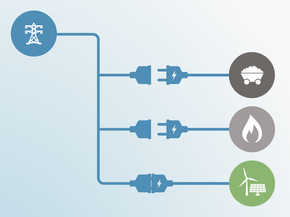Country summary
Overview
Under the Biden Administration, the US has seen promising signs of the impact of the Inflation Reduction Act (IRA). The IRA is mobilising historic levels of investment in clean energy solutions and activating subnational and non-state action on climate change. The US Environmental Protection Agency’s (EPA) recently revised regulations in the power and transport sectors further enhance the government’s climate policy package.
Although the country has made progress under the Biden Administration, the US will still be far from meeting its domestic climate target—let alone aligning its emissions with a 1.5°C trajectory—without additional, drastic emissions reductions measures. To meet its domestic target, the US would need to bolster its policy packages at the sectoral level to address the rising demand for electricity across sectors.
The government would also need to reverse the trend of increasing fossil fuel extraction. CAT analysis in 2022 shows the US is also moving in the wrong direction regarding its international support for fossil fuels. Overall, the CAT rates the US climate targets, action, and climate finance at the end of the Biden Administration as “Insufficient”. An assessment of the impact of the Trump Administration will follow once information is available.
On 5 November 2024, former President Donald Trump won the US election, and will take office on 20 January 2025. The US will continue to face the challenges in meeting its 2030 Nationally Determined Contribution (NDC) and achieving future climate goals aligned with a 1.5°C pathway. Reaching these targets will require the implementation of additional policies, which may prove challenging under the Trump Administration. However, opportunities remain for climate action at the state and municipality level and for furthering the progress made under the IRA.
As of 2022, the US has achieved about one-third of its 2030 emissions reduction target. CAT current policies projections, which include the IRA, show a more pronounced reduction in emissions until 2030 compared to historic reductions. Although CAT projections suggest the US will close the gap by an additional 30%–44% by 2030, it is still 23%–37% short of meeting its 2030 emissions reduction target; evidence that further action is critically necessary. The current US target of 50–52% emissions reductions below 2005 levels by 2030 is not 1.5˚C compatible.
Although there have been positive developments under the IRA, oil and gas production has increased under the Biden Administration. The US is the world’s largest crude oil producer and achieved record-level production in 2023. The country is also the worlds' largest fossil gas producer and, in 2022, became the world’s largest exporter for liquified natural gas (LNG). In 2022, fossil fuels also received the largest subsidies from the government since 2010. In early 2024, the Biden Administration placed a temporary moratorium on pending LNG export terminals. However, the administration continues to approve large-scale fossil fuel projects.
The IRA has had its most positive impact on the power sector. The government’s decarbonisation target for the power sector aligns with the CAT’s Paris Agreement-compatible benchmarks, as well as with the International Energy Agency’s (IEA) net zero strategy: by 2035, the US aims to achieve net zero emissions in the sector. The IRA has stimulated large investment in technologies critical for decarbonising the power sector, but barriers remain; especially since the demand for electricity is expected to grow significantly. Important areas for the power sector's transition, such as the electricity grid, have been significantly underfunded. The anticipated coal phase-out, as out outlined in the recently revised EPA standards, will be too late to be Paris Agreement compatible, and fossil gas-fired plants are largely exempt from the standards.
In the transport sector, the IRA has particularly supported the manufacturing and uptake of electric vehicles (EVs), while the EPA has enhanced the regulatory framework for EVs by revising its emissions standards until 2032. The government aims to decarbonise the sector by 2050. However, this timeline is not compatible with the Paris Agreement. The IRA has spurred significant investment in the domestic EV value chain, especially in battery manufacturing, and the deployment of HDVs in commercial and public fleets. The act also expands subsidies for EV purchases and unlocks new funding for public transport.
A major ambition gap continues to exist in the industry sector, where the government has set a decarbonisation objective but has not specified a clear timeline for reaching the objective. The IRA provides a patchwork of instruments to support technologies to decarbonise the industry sector. The IRA unlocks billions in funding for industrial technologies in their research and development phase, while introducing and expanding tax credits for carbon capture, utilisation, and storage deployment, renewable energy and critical material projects, and clean hydrogen production. The American Innovation and Manufacturing Act (AIM) continues to phase down F-gases significantly.
The government’s emissions reductions targets for the buildings sector are not aligned with the Paris Agreement. Due to limited federal measures to regulate building energy use and emissions, the decarbonisation of the sector will likely heavily rely on electrification. Without further efforts to reduce building envelope energy use and emissions, this dependency will put increasing pressure on the power sector and its decarbonisation.
The agriculture sector lacks a clear decarbonisation objective and, while the IRA allocates funding to boost conservation programmes, the act’s measures do not seem to meaningfully reduce sectoral emissions and even include funding for livestock production. The US has neither developed or implemented any regulations to address emissions from animal production, nor has it meaningfully encouraged dietary change. Such demand-side changes could result in large mitigation impacts in the US, which has one of the highest rates of meat and dairy consumption in the world.
Net forest sinks are threatened by land conversion, increasing demand for timber products, and more frequent natural disturbances from climate change. The IRA increased funding for the National Forest Service and other programmes that support the preservation of carbon sinks and nature-based climate mitigation activities, but logging efforts are nevertheless set to increase.
Aside from strengthening its sectoral policies and targets and reducing fossil fuel exploitation and exportation, the US should address gaps in its international climate contributions:
- Increase international climate finance contributions and cease funding fossil fuels abroad. The Biden Administration is still far from reaching its pledge of USD 11.4bn/year. In FY2023, only USD 1bn was appropriated for climate finance by the US Congress. The US also broke its commitment to stop financing fossil fuels abroad when the American Export-Import Bank (EXIM) lent USD 100m to Indonesia to expand an oil refinery in May 2023.
- Increase the ambition of its NDC. The US has not yet updated its climate target despite the commitment to do so by countries at COP26 in 2021. For the US climate target to be compatible with a 1.5°C trajectory, the country must reduce its emissions by at least 62%–65% below 2005 levels by 2030 (including emissions from land use, land use change and forestry, or LULUCF), while providing more financial support to other countries.
Description of CAT ratings
The CAT rates each country’s targets and policies against (1) its fair share contribution to climate change mitigation considering a range of equity principles including responsibility, capability, and equality, and (2) what is technically and economically feasible using modelled domestic pathways which, in absence of a better method, are based on global least-cost climate change mitigation.
Comparing a country’s fair share ranges and modelled domestic pathways provides insights into which governments should provide climate finance and which should receive it. Developed countries with large responsibility for historical emissions and high per-capita emissions, must not only implement ambitious climate action domestically but must also support climate action in developing countries with lower historical responsibility, capability, and lower per-capita emissions.
The CAT rates the combination of the US 2030 climate targets, policies, and climate finance as “Insufficient”. The “Insufficient” rating indicates that the totality of the government’s policies and proposals need substantial improvements to be consistent with the Paris Agreement’s 1.5°C temperature limit.
The US 2030 domestic emissions reduction target (NDC) is consistent with 2°C of warming when compared to modelled domestic emissions pathways, but not yet consistent with the Paris Agreement’s 1.5°C temperature limit. US policies and action lead to falling emissions in 2030, but not by enough to meet either its targets or the 1.5°C limit.
The US does not meet its fair-share contributions to climate change and, in addition to strengthening its domestic targets and policies, needs to provide and mobilise further support to developing countries.
The US will need to implement additional policies to reach its mitigation targets. The CAT projects US GHG emissions in 2030 to be 29%–39% below 2005 levels (excl. LULUCF), falling short of its 2030 NDC target (44%–49% excl. LULUCF), and significantly short of its fair share target.
On August 16, 2022, President Biden signed the Inflation Reduction Act (IRA) into law. Although the IRA includes several concessions to the fossil fuel industry, it is the most ambitious climate policy package in US history and brings the country closer to meeting its 2030 target.
Although the IRA is a major step towards achieving the US NDC, the government still needs to introduce additional policies and action to achieve its domestic emissions reduction target. EPA standards in the power and transport sector passed in 2024 are important complementary instruments. However, more ambitious (sectoral) climate policies at the federal and state levels are still needed to reach the US targets. The increasing trend in oil and gas production also needs to be reversed.
The projected emissions trajectory range in this update is wider than in the previous update, due to the inclusion of a broader set of models to estimate the IRA's impact. The range of policy projections for the US falls into the “Insufficient” category but reaches the “Almost sufficient” category at its lower end.
The “Insufficient” rating indicates that the government’s climate policies and action in 2030 need substantial improvement to be consistent with the 1.5°C temperature limit. If all countries were to follow the US approach, warming would reach over 2°C and up to 3°C.
See full summary of policies and actions here.
We rate the US domestic target of reducing emissions by 50%–52% (or 44%–49% excl. LULUCF) below 2005 levels by 2030 as “Almost sufficient” when compared to modelled domestic emissions pathways. The “Almost sufficient” rating indicates that the US domestic target for 2030 is not yet consistent with the 1.5°C temperature limit but could be, with moderate improvements. If all countries were to follow the US approach, warming could be held at—but not well below—2°C.
We rate the US target of reducing emissions by 50%–52% (or 44%–49% excl. LULUCF) below 2005 levels by 2030 as “Insufficient” when compared with its fair-share emissions allocation.
The CAT’s assessment of the US’ total fair share contribution takes into account its emissions reduction target and its climate finance.
The “Insufficient” rating indicates that the 2030 target needs substantial improvements to be consistent with the 1.5°C temperature limit. Some of these improvements should be made to the domestic emissions target itself, others could come in the form of further financial support for emissions reductions achieved in developing countries. If all countries were to follow the US approach, warming would reach up to 3°C.
We rate the United States’ international public climate finance contributions as “Critically Insufficient”. This rating is based on the government’s 2022 OECD contributions. The Biden Administration committed to increase its climate finance contributions but contributions until 2024 remain low compared to its fair share. In FY2024, only USD 1bn (approximately the same amount as in 2023) were appropriated for climate finance by Congress.
While the government claims larger sums have been made available (notably, USD 5.8 bn in 2022), these funds mainly relate to adaptation and/or are not principal financing. Only principal mitigation financing is accounted for in the CAT's rating. To improve its rating, the US needs to ramp up the level of its international climate finance contributions and stop supporting fossil fuels abroad.
The US’ climate finance is not sufficient to improve the rating of its NDC against its fair share, and the CAT rates the US’s overall fair share contribution as “Insufficient”.
We evaluate the US net zero target as: Average. The Biden Administration submitted an updated long-term strategy (LTS) to the UNFCCC in November 2021 (U.S. Department of State, 2021), in which the US officially commits to reaching net zero emissions by 2050 latest.
The net zero target covers all GHG emissions, makes transparent assumptions on CO2 removal by nature- and technology-based solutions, and specifies several key components for comprehensive planning.
The US government has several avenues to improve the scope, target architecture, and transparency of its net zero target, such as including international aviation and shipping in its target coverage, and explicitly committing to reach net zero emissions within its own borders without any use of international offsets.
Further analysis
Latest publications
Stay informed
Subscribe to our newsletter






